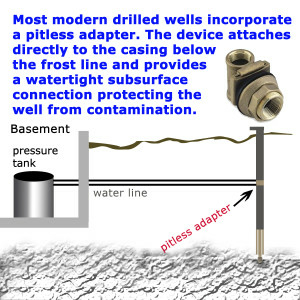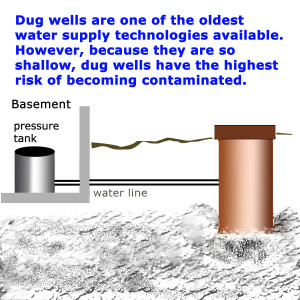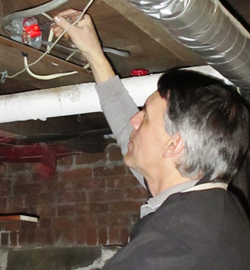Water Quality and Well Yield Testing
 Home and Hearth Inspections can draw a sample of your drinking water (especially important if you have a well) and have it analyzed for bacteria, physical characteristics (such as pH and hardness), the presence of organic and inorganic chemicals, radon, lead and numerous other attributes. We can also test the quality of the water from your well. This is especially important if the house has a septic system or is located near an area of regular pesticide use (e.g., farm; nursery) or near an industrial area.
Home and Hearth Inspections can draw a sample of your drinking water (especially important if you have a well) and have it analyzed for bacteria, physical characteristics (such as pH and hardness), the presence of organic and inorganic chemicals, radon, lead and numerous other attributes. We can also test the quality of the water from your well. This is especially important if the house has a septic system or is located near an area of regular pesticide use (e.g., farm; nursery) or near an industrial area.
We use state certified laboratories that perform similar water tests for public wells owned by towns throughout Massachusetts and Rhode Island. This process is accepted by mortgage providers and towns that have specific requirements on well water.
If you would like more information on your drinking water, click on the link below:
http://www.mass.gov/dep/brp/dws/faqs.htm
We will also inspect the well equipment located in your basement and determine if it is operating correctly. However, a Home Inspector usually does not inspect the well itself or its capacity. We can test the well as an additional service for an additional charge.
Well Yield Testing
Call for prices. We only use state certified labs in MA & RI
When you own a well, you want to make sure it delivers a sufficient quantity of good clean water to meet the needs of your family.
This can be done during your home inspection or as a separate tests. It consist of 2 different procedures.
The first is to test your water quality. We use a state certified laboratory to do this. Massachusetts does not require certified labs for private well testing. However, we use this more complicated and expensive process so you can be sure that you are receiving the same testing as done on public water systems.
There are a number of different things you can check in your water. The most common tests ensure the water is “potable” (suitable for human consumption). Another popular test is a Title V test to ensure there is no interaction between your well and your septic system. You can also test for pesticides, herbicides, lead in your water, bacteria in the water, etc.
The second is to test your well yield. We test your well for an extended time to ensure it can meet the needs of the house. Occasionally, your mortgage provider or local town has specific minimum criteria that must be met for a well. Our test uses your criteria or the following calculation:
A typical well flow/quantity test takes about 4 hours. Generally, a well should deliver at least 5 gallons per minute for 4 hours with no significant change in flow. This will deliver about 1,200 gallons of water.
(number of bedrooms plus one bedroom) x (110 gallons per bedroom) x (a safety factor of 2) = number of gallons needed daily
Plus
measured static water level and the depth and radius of casing (The 6-inch diameter well will hold about 1.5 gallons of water per foot of casing while an 8-inch diameter well will hold approximately 2.6 gallons/ft.)
Following the pumping test, the water level in the well must be shown to recover to within 85 percent of the prepumped static water level within a 24 hour period.
For a 3 bedroom house with a well that is eight (8) inches in diameter and contains 200 ft. of standing water:
(3 bedrooms plus 1) x (110 gallons per bedroom) x (2) = 880 gallons needed daily.
The volume of an 8 inch well is 2.60 gallons for every foot of length. Therefore, (200 ft. of standing water) x (2.60 gal/ft.) = 520 gallons.
880 gallons + 520 gallons = 1,400 gallons that must be pumped from the well in 24 hours or less to demonstrate suitable capacity. If the well casing is only 6 inches, the number drops to 1,180.
Types of Wells
Almost half of the United States depends on ground water for its drinking water supply. If you have a well, it’s important to understand the different materials that comprise your well system.
Drilled Wells
 The most common water supply for the home that is not served by a public system is a drilled well. They are constructed by either percussion or rotary-drilling machines that penetrate about 100-400 feet into the bedrock. Where you find bedrock at the surface, it is commonly called ledge. To serve as a water supply, a drilled well must intersect bedrock fractures containing ground water.
The most common water supply for the home that is not served by a public system is a drilled well. They are constructed by either percussion or rotary-drilling machines that penetrate about 100-400 feet into the bedrock. Where you find bedrock at the surface, it is commonly called ledge. To serve as a water supply, a drilled well must intersect bedrock fractures containing ground water.
The upper part of a well is lined with casing to prevent well walls from collapsing and contaminants from entering the water supply. The casing is usually metal or plastic pipe, six inches in diameter that extends into the bedrock to prevent shallow ground water from entering the well. The casing must extend at least 18 feet into the ground, with at least five feet extending into the bedrock. The casing should also extend a foot or two above the surface of your lawn. A sealant, such as cement grout or bentonite clay, should be poured along the outside of the casing to the top of the well. The well is capped to prevent surface water from entering the well.
Submersible pumps, located near the bottom of the well, are commonly used in drilled wells. Wells with a shallow water table may have jet pumps inside the home. Most modern drilled wells incorporate a pitiless adapter designed to provide a sanitary seal at the point where the discharge water line leaves the well to enter the home. The device attaches directly to the casing below the frost line and provides a watertight subsurface connection, protecting the well from contamination.
Dug Wells
 Dug wells are one of the oldest water supply technologies available. They are created by digging a hole in the ground with a shovel or backhoe. Dug wells have usually been excavated below the groundwater table until incoming water exceeded the digger’s bailing rate. The well was then lined (cased) with stones, brick, tile, or other material to keep it from collapsing. It was covered with a cap of wood, stone, or concrete. Since it is so difficult to dig beneath the ground water table, dug wells are not very deep. Typically, they are only 10 to 30 feet deep.
Dug wells are one of the oldest water supply technologies available. They are created by digging a hole in the ground with a shovel or backhoe. Dug wells have usually been excavated below the groundwater table until incoming water exceeded the digger’s bailing rate. The well was then lined (cased) with stones, brick, tile, or other material to keep it from collapsing. It was covered with a cap of wood, stone, or concrete. Since it is so difficult to dig beneath the ground water table, dug wells are not very deep. Typically, they are only 10 to 30 feet deep.
Dug wells are not common in New England and are more usually found on land formerly used for farming. However, because they are so shallow, dug wells have the highest risk of becoming contaminated. These wells also tend to go dry during a drought when the ground water table drops.
To minimize the likelihood of contamination, a dug well should be cased with a watertight material and a cement grout or bentonite clay sealant poured along the outside of the casing to the top of the well. It should be covered by a concrete curb and cap that stands about a foot above the ground. The land surface around the well should be mounded to allow surface water to run away from the well.
Driven Wells
 Driven wells are made by driving a tube into the earth to a water table above the bedrock. Also referred to as a sand point well, the driven well can only be constructed in areas with loose or sandy soil. Lengths of pipe with a well-point at the end are driven into the ground to reach the water, which flows into the pipe through the screened openings in the well-point. The driven well is typically 2 inches in diameter and up to 30 feet in depth. Driven wells are commonly used for irrigation. Similar to dug wells, driven wells are relatively shallow and have high risk of contamination.
Driven wells are made by driving a tube into the earth to a water table above the bedrock. Also referred to as a sand point well, the driven well can only be constructed in areas with loose or sandy soil. Lengths of pipe with a well-point at the end are driven into the ground to reach the water, which flows into the pipe through the screened openings in the well-point. The driven well is typically 2 inches in diameter and up to 30 feet in depth. Driven wells are commonly used for irrigation. Similar to dug wells, driven wells are relatively shallow and have high risk of contamination.
To minimize this risk, the well cover should be a tight-fitting concrete curb and cap with no cracks and should sit about a foot above the ground. Slope the ground away from the well so that surface water runs away from the well.
Inspector Profiles
Inspection Services
Do You Have a Question?
Do you have a question relating to home inspections ? We can help. Simply fill out the form below and we’ll contact you with the answer, with no obligation to you. We guarantee your privacy.
MEMBERSHIPS & CERTIFICATIONS

As a member of the International Association of Certified Home Inspectors, we adhere to a strict code of ethics as a home inspector. The code of ethics can be viewed here: International Association of Certified Home Inspectors (InterNACHI) website.



Radon Gas Testing
/0 Comments/in Inspection Services /by pippindesignRadon Gas is created when uranium in the soil decays. The gas then seeps through any access point into a home.
Water Quality Testing & Well Yield Testing
/0 Comments/in Inspection Services /by pippindesignTesting your drinking water for the presence of organic and inorganic chemicals.
Inspections for Wood Destroying Insects
/0 Comments/in Inspection Services /by pippindesignTermites and other wood destroying insects such as carpenter ants can do massive damage to a home.
Pre-Sale Inspections for Sellers
/0 Comments/in Inspection Services /by pippindesignIf you are selling a home, you’ll get the highest price in the shortest time, if your home is in top condition.
Home and Condo Inspections
/0 Comments/in Inspection Services /by pippindesignThe inspection report will tell you what needs to be repaired and what routine maintenance tasks you should perform to keep the house in top condition.
Multi-family Home Inspections
/0 Comments/in Inspection Services /by pippindesignThere are good reasons to have a professional inspection performed on the new home or investment property you are buying. Buying a new house is likely the largest purchase decision you’ll ever make. The whole process is fraught with emotion and stress.